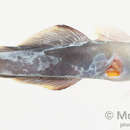Diagnostic Description
provided by Fishbase
Light bluish gray in life, shading posteriorly to black; snout blackish; operculum with iridescent blue markings. Chin with a low fleshy protuberance, narrowing posteriorly to a low longitudinal fold. Caudal fin lobes blackish to dark reddish, broad centro-posterior region of fin whitish to yellowish; 1st dorsal fin dull orangish; 2nd dorsal and anal fins largely blackish; pectoral base with an orange to orange-red bar edged in blue. Juveniles with an oval black spot larger than eye at lower base of caudal fin.
- Recorder
- Estelita Emily Capuli
Life Cycle
provided by Fishbase
Monogamous mating is observed as both obligate and social (Ref. 52884).
Morphology
provided by Fishbase
Dorsal spines (total): 7; Dorsal soft rays (total): 23 - 26; Analspines: 1; Analsoft rays: 23 - 26; Vertebrae: 26
- Recorder
- Estelita Emily Capuli
Trophic Strategy
provided by Fishbase
Adults usually in pairs, juveniles in small aggregations. Usually hover in small schools of up to ten or more individuals over the reefs (Ref. 6110).
- Recorder
- Estelita Emily Capuli
Biology
provided by Fishbase
Occurs in outer reef slopes, also inhabits lagoons and bays. Usually in pairs as adults and in small aggregations as juveniles, Ref. 48637. Monogamous (Ref. 52884). Feeds on zooplankton while hovering 1 to 2 m above the bottom. Swims away from danger rather than retreat to its burrow.
- Recorder
- Estelita Emily Capuli
Importance
provided by Fishbase
aquarium: commercial
- Recorder
- Estelita Emily Capuli
Ptereleotris evides
provided by wikipedia EN
Ptereleotris evides, the Blackfin dartfish, is a species of dartfish native to the Indian Ocean and the western Pacific Ocean. It is a reef inhabitant and can be found at depths of from 2 to 15 metres (6.6 to 49.2 ft). This species can reach a length of 14 centimetres (5.5 in) TL. It can also be found in the aquarium trade.[2]
References

- license
- cc-by-sa-3.0
- copyright
- Wikipedia authors and editors
Ptereleotris evides: Brief Summary
provided by wikipedia EN
Ptereleotris evides, the Blackfin dartfish, is a species of dartfish native to the Indian Ocean and the western Pacific Ocean. It is a reef inhabitant and can be found at depths of from 2 to 15 metres (6.6 to 49.2 ft). This species can reach a length of 14 centimetres (5.5 in) TL. It can also be found in the aquarium trade.
- license
- cc-by-sa-3.0
- copyright
- Wikipedia authors and editors
Description
provided by World Register of Marine Species
Occurs in outer reef slopes, also inhabits lagoons and bays. Usually in pairs as adults and in small aggregations as juveniles. Feeds on zooplankton while hovering 1 to 2 m above the bottom.
Froese, R. & D. Pauly (Editors). (2023). FishBase. World Wide Web electronic publication. version (02/2023).
- license
- cc-by-4.0
- copyright
- WoRMS Editorial Board

